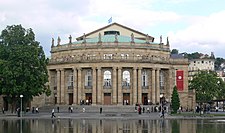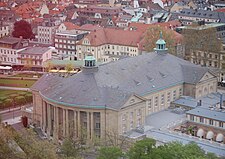
Max Littmann (3 January 1862 - 20 September 1931) was a German architect.
Education




Littmann was educated in the Gewerbeakademie Chemnitz and the Technische Hochschule Dresden. In 1885, he moved to Munich where he met Friedrich Thiersch and Gabriel von Seidl and where - after two study trips to Italy and Paris - he established himself as a free architect.
Career
In 1891, he joined the contracting business of his father-in-law Jakob Heilmann, thus transforming it into the Heilmann & Littmann general partnership (later becoming a limited partnership), taking charge of the planning department. Littmann excelled in the erection of magnificent buildings, e. g. theaters, department stores and spas and was the perfect supplement to Heilmann, who had specialized in living house construction.[ citation needed]
February 1905 two department stores opened their door in Munich, both designed by Littmann, who at the time had already achieved the status of a prominent architect in Munich. The Kaufhaus Oberpollinger and the Warenhaus Hermann Tietz were both prominently positioned in central Munich near the München Hauptbahnhof (Munich Central Train Station). Littmann designed both department stores so that the exteriors were historicist, while the interiors provided consumers with a modern shopping environment. Littmann arranged both department stores around an atrium with a glass and iron cupola. Littmann also insisted on state of the art building techniques, such as reinforcing steel, and reinforced concrete. [1] Littmann hired renown Munich artists to help with the design of the two department stores, including Heinrich Düll, Georg Pezold, and Julius Seidl. [2]
Defamation
Even during his lifetime, Littmann was listed in the Encyclopaedia Judaica. His pedigree doesn't give any clue on the often referred Jewish descent, rather he is descended from a Protestant family in Oschatz ( Saxony), which can be traced back for centuries.
Buildings (selection)
- 1896-1897 Hofbräuhaus in Munich
- 1898-1900 Kurhaus (spa building) in Bad Reichenhall
- 1900-1901 Prinzregententheater in Munich
- 1904-1905 Kurtheater in Bad Kissingen
- 1905-1906 Schillertheater in Berlin
- 1906-1907 Deutsches Nationaltheater in Weimar
- 1907-1908 Münchner Künstler-Theater in Munich
- 1909–1912 Königlich Württembergisches Hoftheater in Stuttgart (opera house)
- 1910-1913 Regentenbau (concert hall) and Wandelhalle (spa building) in Bad Kissingen
- 1926-1927 Kurhausbad (spa building) in Bad Kissingen
Publications
- Littmann, Max: Das Charlottenburger Schiller-Theater. München: Bruckmann [ca. 1906].
- Littmann, Max: Das Münchner Künstlertheater. München: Werner 1908.
- Littmann, Max: Das Großherzogliche Hoftheater in Weimar. Denkschrift zur Feier der Eröffnung. München: Werner 1908.
- Littmann, Max: Die Königlichen Hoftheater in Stuttgart. Darmstadt: Koch 1912.
References
- ^ Sabine Wieber (2021). Jugendstil Women and the Making of Modern Design. Bloomsbury Publishing. p. 169. ISBN 9781350088535.
- ^ Sabine Wieber (2021). Jugendstil Women and the Making of Modern Design. Bloomsbury Publishing. p. 171. ISBN 9781350088535.
External links
- Max Littmann in the German National Library catalogue